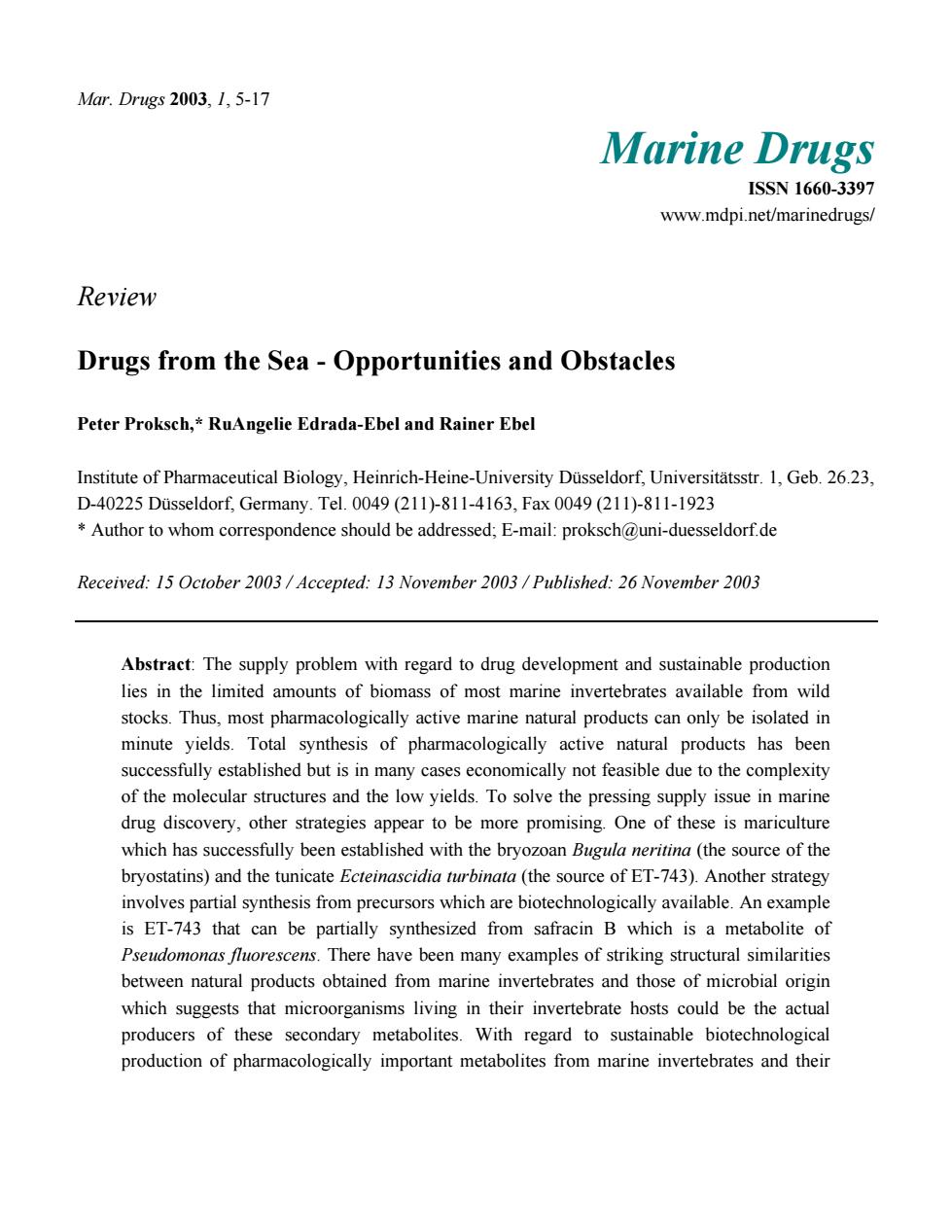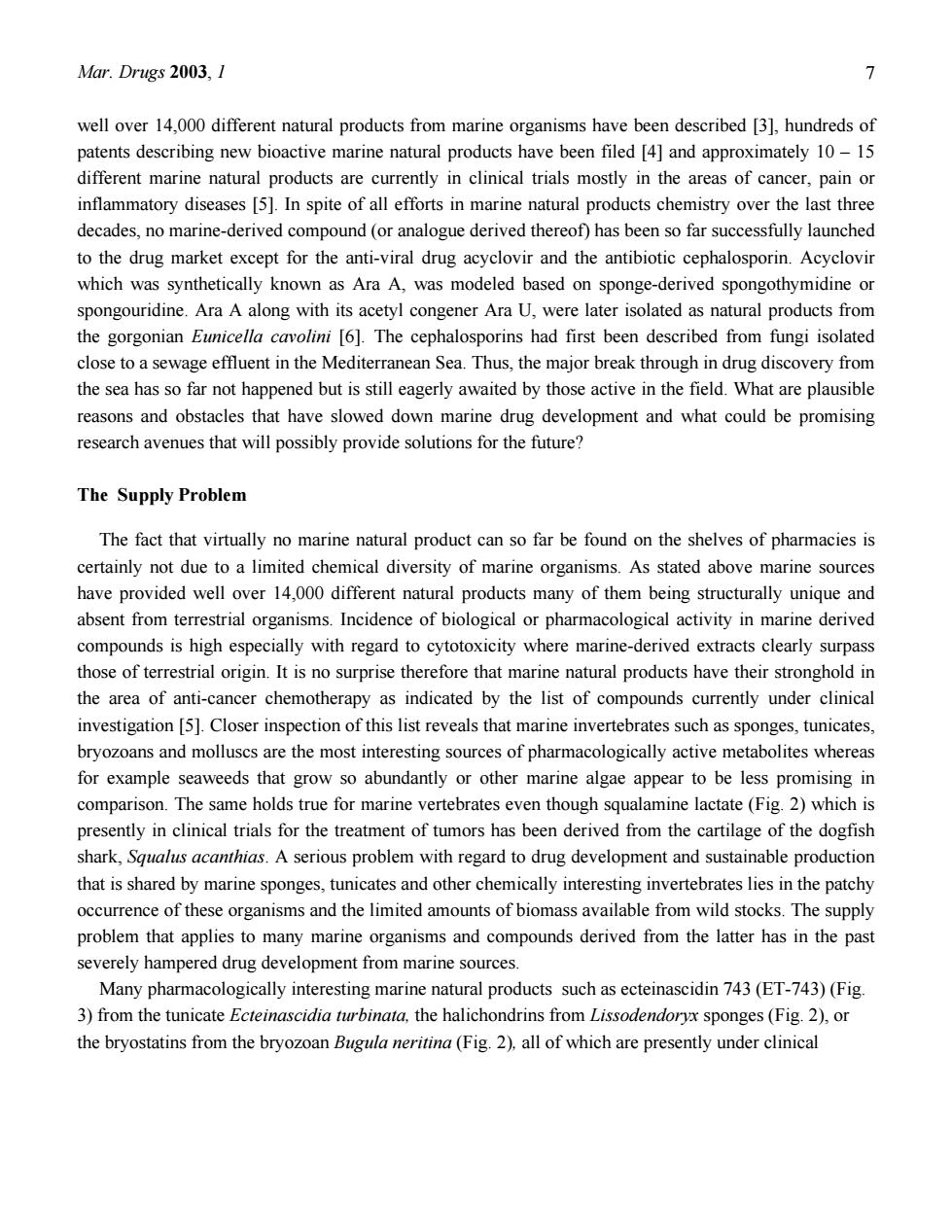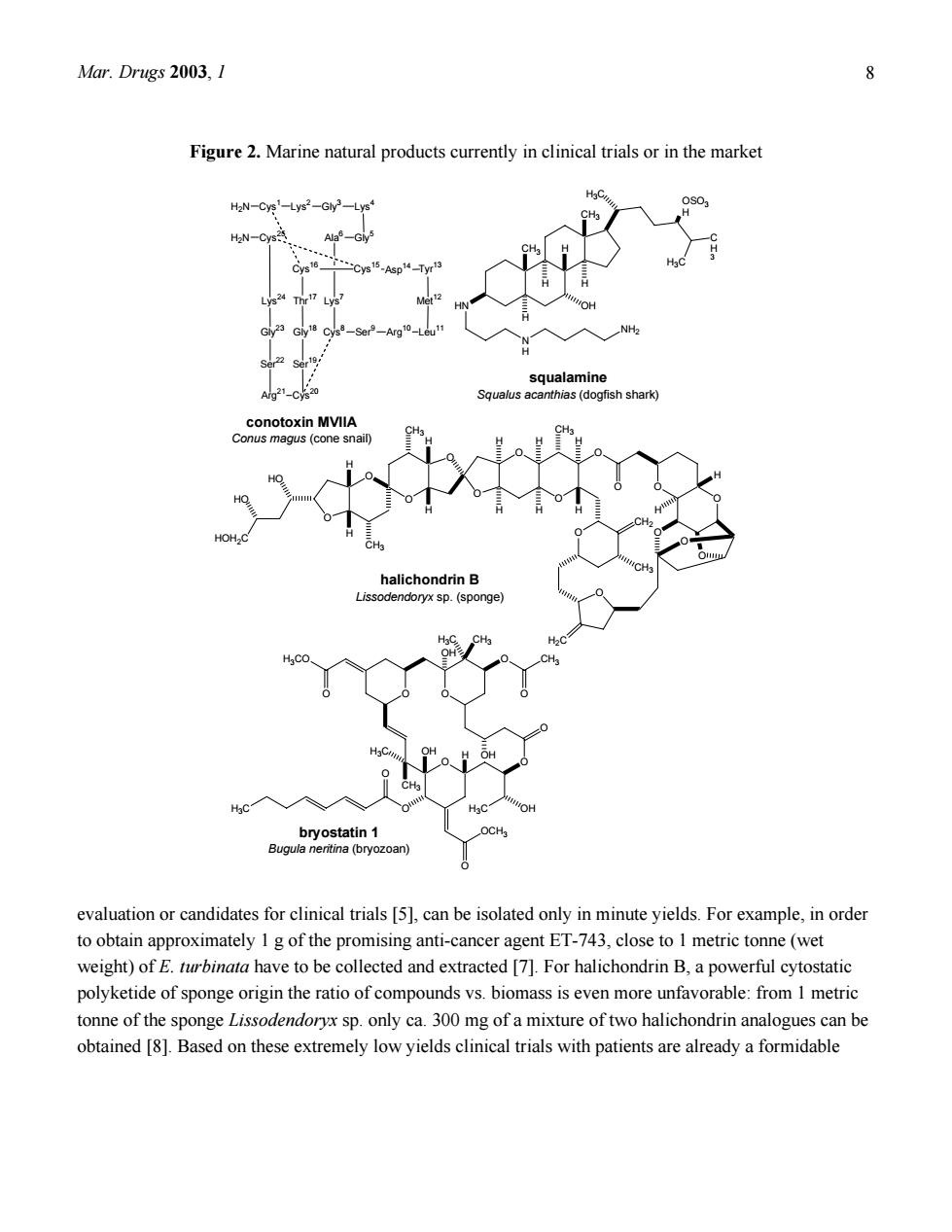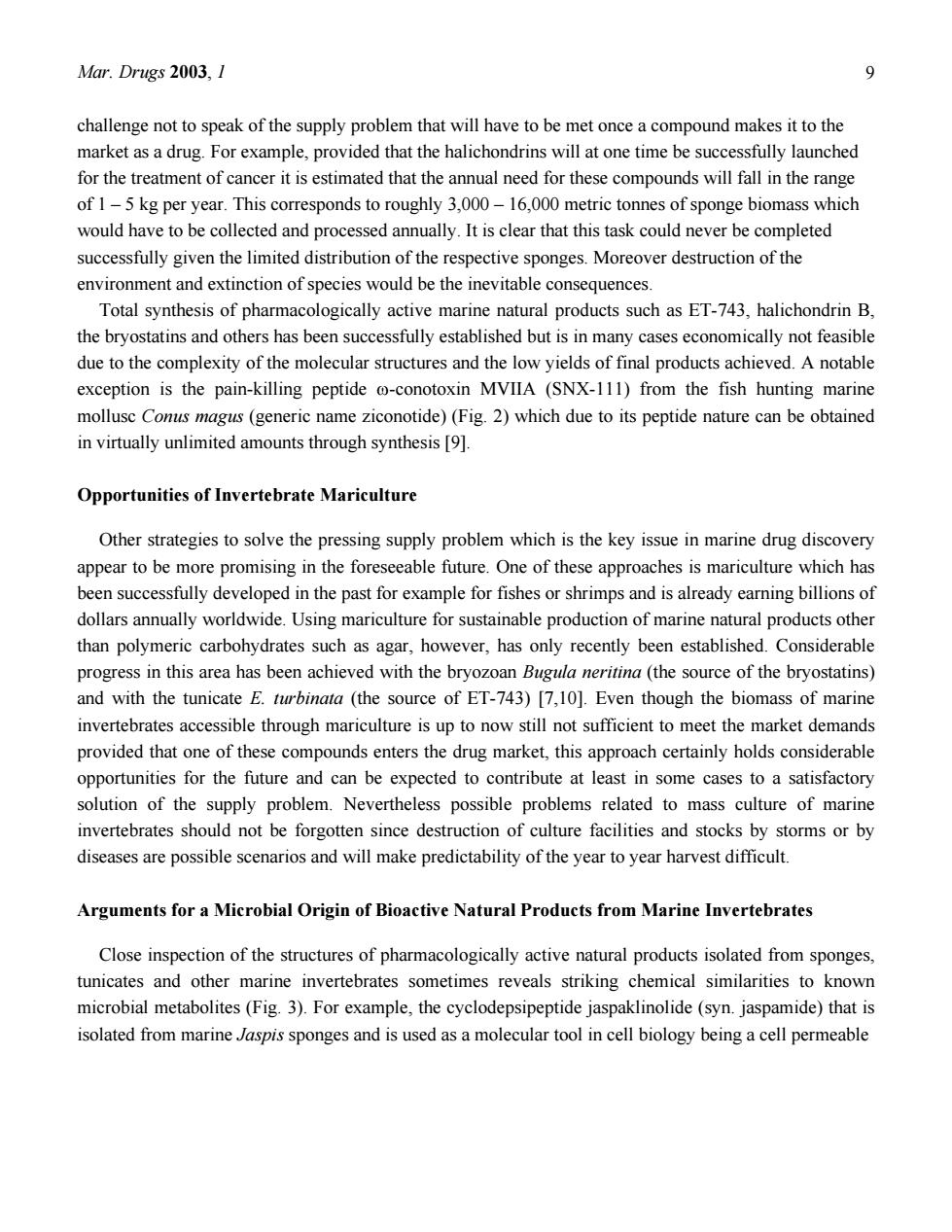
Mam.Drugs2003,1,5-17 Marine Drugs ISSN1660-3397 www.mdpi.net/marinedrugs/ Review Drugs from the Sea-Opportunities and Obstacles Peter Proksch,*RuAngelie Edrada-Ebel and Rainer Ebel Institute of Pharmaceutical Biology,Heinrich-Heine-University Dusseldorf,Universitatsstr.1,Geb.26.23, D-40225D0 sseldorf,Germany.Tel.0049(211)-811-4163,Fax0049(211)-811-1923 *Author to whom correspondence should be addressed:E-mail:proksch@uni-duesseldorf.de Received:15 October 2003/Accepted:13 November 2003/Published:26 November 2003 Abstract:The supply problem with regard to drug development and sustainable production lies in the limited amounts of biomass of most marine invertebrates available from wild stocks.Thus,most pharmacologically active marine natural products can only be isolated in minute yields.Total synthesis of pharmacologically active natural products has been successfully established but is in many cases economically not feasible due to the complexity of the molecular structures and the low yields.To solve the pressing supply issue in marine drug discovery,other strategies appear to be more promising.One of these is mariculture which has successfully been established with the bryozoan Bugula neritina (the source of the bryostatins)and the tunicate Ecteinascidia turbinata(the source of ET-743).Another strategy involves partial synthesis from precursors which are biotechnologically available.An example is ET-743 that can be partially synthesized from safracin B which is a metabolite of Pseudomonas fluorescens.There have been many examples of striking structural similarities between natural products obtained from marine invertebrates and those of microbial origin which suggests that microorganisms living in their invertebrate hosts could be the actual producers of these secondary metabolites.With regard to sustainable biotechnological production of pharmacologically important metabolites from marine invertebrates and their
Mar. Drugs 2003, 1, 5-17 Marine Drugs ISSN 1660-3397 www.mdpi.net/marinedrugs/ Review Drugs from the Sea - Opportunities and Obstacles Peter Proksch,* RuAngelie Edrada-Ebel and Rainer Ebel Institute of Pharmaceutical Biology, Heinrich-Heine-University Düsseldorf, Universitätsstr. 1, Geb. 26.23, D-40225 Düsseldorf, Germany. Tel. 0049 (211)-811-4163, Fax 0049 (211)-811-1923 * Author to whom correspondence should be addressed; E-mail: proksch@uni-duesseldorf.de Received: 15 October 2003 / Accepted: 13 November 2003 / Published: 26 November 2003 Abstract: The supply problem with regard to drug development and sustainable production lies in the limited amounts of biomass of most marine invertebrates available from wild stocks. Thus, most pharmacologically active marine natural products can only be isolated in minute yields. Total synthesis of pharmacologically active natural products has been successfully established but is in many cases economically not feasible due to the complexity of the molecular structures and the low yields. To solve the pressing supply issue in marine drug discovery, other strategies appear to be more promising. One of these is mariculture which has successfully been established with the bryozoan Bugula neritina (the source of the bryostatins) and the tunicate Ecteinascidia turbinata (the source of ET-743). Another strategy involves partial synthesis from precursors which are biotechnologically available. An example is ET-743 that can be partially synthesized from safracin B which is a metabolite of Pseudomonas fluorescens. There have been many examples of striking structural similarities between natural products obtained from marine invertebrates and those of microbial origin which suggests that microorganisms living in their invertebrate hosts could be the actual producers of these secondary metabolites. With regard to sustainable biotechnological production of pharmacologically important metabolites from marine invertebrates and their

Mar.Drugs 2003,1 6 "endosymbionts",a more advanced strategy is to focus on cloning and expression of the respective key biosynthetic gene clusters.This molecular biological approach will open up new avenues for biotechnological production of drugs or drug candidates from the sea. Keywords:drugs from the sea,mariculture,endosymbionts,biotechnology Introduction Among the various sources for the development of new drugs,compounds from living organisms,so called natural products,are of particular significance [1].Approximately one third of today's best selling drugs are either natural products or have been developed based on lead structures provided by nature. Traditionally higher plants used to be the most prolific sources of drugs from nature.Recent examples of plant-derived anti-cancer drugs include paclitaxel (taxol)from Taxus brevifolia,etoposide (vepesid) derived by partial synthesis from the lignan podophyllotoxin isolated from Podophyllum peltatum and irinotecan(camptosar)obtained based on the lead structure of camptothecin isolated from Camptotheca acuminata.Use of medicinal plants is well documented throughout human history but is by no means restricted to humans as apes such a chimpanzees have been shown to use plants for the treatment of wounds or to fight intestinal parasites. Looking at drugs from nature it is surprising that up to now almost all medicinally used natural products or derivatives thereof were obtained from terrestrial organisms rather than from those inhabiting the sea.The oceans cover more than 70%of the earth'surface and are an indispensable source of protein for human nutrition.With regard to drug discovery and development,however,the oceans started to attract interest from pharmaceutical companies and research institutions only approximately 50 years ago with the discovery of the sponge-derived nucleosides spongothymidine and spongouridine [2](Fig.1). Since then Figure 1.Antiviral nucleosides from sponges spongothymidine spongouridine from the sponge Cryptotethia crypta
Mar. Drugs 2003, 1 6 “endosymbionts”, a more advanced strategy is to focus on cloning and expression of the respective key biosynthetic gene clusters. This molecular biological approach will open up new avenues for biotechnological production of drugs or drug candidates from the sea. Keywords: drugs from the sea, mariculture, endosymbionts, biotechnology. Introduction Among the various sources for the development of new drugs, compounds from living organisms, so called natural products, are of particular significance [1]. Approximately one third of today´s best selling drugs are either natural products or have been developed based on lead structures provided by nature. Traditionally higher plants used to be the most prolific sources of drugs from nature. Recent examples of plant-derived anti-cancer drugs include paclitaxel (taxol) from Taxus brevifolia, etoposide (vepesid) derived by partial synthesis from the lignan podophyllotoxin isolated from Podophyllum peltatum and irinotecan (camptosar) obtained based on the lead structure of camptothecin isolated from Camptotheca acuminata. Use of medicinal plants is well documented throughout human history but is by no means restricted to humans as apes such a chimpanzees have been shown to use plants for the treatment of wounds or to fight intestinal parasites. Looking at drugs from nature it is surprising that up to now almost all medicinally used natural products or derivatives thereof were obtained from terrestrial organisms rather than from those inhabiting the sea. The oceans cover more than 70% of the earth’surface and are an indispensable source of protein for human nutrition. With regard to drug discovery and development, however, the oceans started to attract interest from pharmaceutical companies and research institutions only approximately 50 years ago with the discovery of the sponge-derived nucleosides spongothymidine and spongouridine [2] (Fig. 1). Since then Figure 1. Antiviral nucleosides from sponges HN N HOH2C OH O OH O O CH3 HN N HOH2C OH O OH O O spongothymidine spongouridine from the sponge Cryptotethia crypta

Mar.Drugs 2003,1 7 well over 14,000 different natural products from marine organisms have been described [3],hundreds of patents describing new bioactive marine natural products have been filed [4]and approximately 10-15 different marine natural products are currently in clinical trials mostly in the areas of cancer,pain or inflammatory diseases [5].In spite of all efforts in marine natural products chemistry over the last three decades,no marine-derived compound(or analogue derived thereof)has been so far successfully launched to the drug market except for the anti-viral drug acyclovir and the antibiotic cephalosporin.Acyclovir which was synthetically known as Ara A,was modeled based on sponge-derived spongothymidine or spongouridine.Ara A along with its acetyl congener Ara U,were later isolated as natural products from the gorgonian Eunicella cavolini [6].The cephalosporins had first been described from fungi isolated close to a sewage effluent in the Mediterranean Sea.Thus,the major break through in drug discovery from the sea has so far not happened but is still eagerly awaited by those active in the field.What are plausible reasons and obstacles that have slowed down marine drug development and what could be promising research avenues that will possibly provide solutions for the future? The Supply Problem The fact that virtually no marine natural product can so far be found on the shelves of pharmacies is certainly not due to a limited chemical diversity of marine organisms.As stated above marine sources have provided well over 14,000 different natural products many of them being structurally unique and absent from terrestrial organisms.Incidence of biological or pharmacological activity in marine derived compounds is high especially with regard to cytotoxicity where marine-derived extracts clearly surpass those of terrestrial origin.It is no surprise therefore that marine natural products have their stronghold in the area of anti-cancer chemotherapy as indicated by the list of compounds currently under clinical investigation [5].Closer inspection of this list reveals that marine invertebrates such as sponges,tunicates bryozoans and molluscs are the most interesting sources of pharmacologically active metabolites whereas for example seaweeds that grow so abundantly or other marine algae appear to be less promising in comparison.The same holds true for marine vertebrates even though squalamine lactate(Fig.2)which is presently in clinical trials for the treatment of tumors has been derived from the cartilage of the dogfish shark,Squalus acanthias.A serious problem with regard to drug development and sustainable production that is shared by marine sponges,tunicates and other chemically interesting invertebrates lies in the patchy occurrence of these organisms and the limited amounts of biomass available from wild stocks.The supply problem that applies to many marine organisms and compounds derived from the latter has in the pas severely hampered drug development from marine sources. Many pharmacologically interesting marine natural products such as ecteinascidin 743(ET-743)(Fig 3)from the tunicate Ecteinascidia turbinata,the halichondrins from Lissodendoryx sponges(Fig.2),or the bryostatins from the bryozoan Bugula neritina(Fig.2)all of which are presently under clinical
Mar. Drugs 2003, 1 7 well over 14,000 different natural products from marine organisms have been described [3], hundreds of patents describing new bioactive marine natural products have been filed [4] and approximately 10 – 15 different marine natural products are currently in clinical trials mostly in the areas of cancer, pain or inflammatory diseases [5]. In spite of all efforts in marine natural products chemistry over the last three decades, no marine-derived compound (or analogue derived thereof) has been so far successfully launched to the drug market except for the anti-viral drug acyclovir and the antibiotic cephalosporin. Acyclovir which was synthetically known as Ara A, was modeled based on sponge-derived spongothymidine or spongouridine. Ara A along with its acetyl congener Ara U, were later isolated as natural products from the gorgonian Eunicella cavolini [6]. The cephalosporins had first been described from fungi isolated close to a sewage effluent in the Mediterranean Sea. Thus, the major break through in drug discovery from the sea has so far not happened but is still eagerly awaited by those active in the field. What are plausible reasons and obstacles that have slowed down marine drug development and what could be promising research avenues that will possibly provide solutions for the future? The Supply Problem The fact that virtually no marine natural product can so far be found on the shelves of pharmacies is certainly not due to a limited chemical diversity of marine organisms. As stated above marine sources have provided well over 14,000 different natural products many of them being structurally unique and absent from terrestrial organisms. Incidence of biological or pharmacological activity in marine derived compounds is high especially with regard to cytotoxicity where marine-derived extracts clearly surpass those of terrestrial origin. It is no surprise therefore that marine natural products have their stronghold in the area of anti-cancer chemotherapy as indicated by the list of compounds currently under clinical investigation [5]. Closer inspection of this list reveals that marine invertebrates such as sponges, tunicates, bryozoans and molluscs are the most interesting sources of pharmacologically active metabolites whereas for example seaweeds that grow so abundantly or other marine algae appear to be less promising in comparison. The same holds true for marine vertebrates even though squalamine lactate (Fig. 2) which is presently in clinical trials for the treatment of tumors has been derived from the cartilage of the dogfish shark, Squalus acanthias. A serious problem with regard to drug development and sustainable production that is shared by marine sponges, tunicates and other chemically interesting invertebrates lies in the patchy occurrence of these organisms and the limited amounts of biomass available from wild stocks. The supply problem that applies to many marine organisms and compounds derived from the latter has in the past severely hampered drug development from marine sources. Many pharmacologically interesting marine natural products such as ecteinascidin 743 (ET-743) (Fig. 3) from the tunicate Ecteinascidia turbinata, the halichondrins from Lissodendoryx sponges (Fig. 2), or the bryostatins from the bryozoan Bugula neritina (Fig. 2), all of which are presently under clinical

Mar.Drugs 2003,1 Figure 2.Marine natural products currently in clinical trials or in the market HaN-Cys-Lys2-Gly- Ser alamin 21-CV alus acanthas (dogfish shan so. evaluation or candidates for clinical trials [5],can be isolated only in minute yields.For example,in order to obtain approximately 1 g of the promising anti-cancer agent ET-743,close to 1 metric tonne(wet weight)of E.rbinata have to be collected and extracted []For halichondrin B,a powerful cytostatic polyketide of sponge origin the ratio of compounds vs.biomass is even more unfavorable:from I metric tonne of the sponge Lissodendoryx sp.only ca.300 mg of a mixture of two halichondrin analogues can be obtained [8].Based on these extremely low yields clinical trials with patients are already a formidable
Mar. Drugs 2003, 1 8 Figure 2. Marine natural products currently in clinical trials or in the market CH3 CH3 H H H H3C C H 3 H3C OSO3 H HN H N H NH2 OH O O O O O O O HO HO HOH2C H H CH3 CH3 H H H H O O O O O O O O O CH3 CH2 H2C H H H H CH3 H H O O O O O H3CO OH H3C CH3 O O CH3 OH O O H3C OH OH H CH3 H3C O OCH3 O H3C Cys1 Lys2 Gly3 Lys4 Gly5 Ala6 Lys7 Cys8 Ser 9 Arg10 Leu11 Met 12 Tyr 13 Asp14 Cys15 Cys16 Thr 17 Gly18 Ser 19 Cys20 Arg21 Ser 22 Gly23 Lys24 Cys25 H2N H2N halichondrin B Lissodendoryx sp. (sponge) bryostatin 1 Bugula neritina (bryozoan) squalamine Squalus acanthias (dogfish shark) conotoxin MVIIA Conus magus (cone snail) evaluation or candidates for clinical trials [5], can be isolated only in minute yields. For example, in order to obtain approximately 1 g of the promising anti-cancer agent ET-743, close to 1 metric tonne (wet weight) of E. turbinata have to be collected and extracted [7]. For halichondrin B, a powerful cytostatic polyketide of sponge origin the ratio of compounds vs. biomass is even more unfavorable: from 1 metric tonne of the sponge Lissodendoryx sp. only ca. 300 mg of a mixture of two halichondrin analogues can be obtained [8]. Based on these extremely low yields clinical trials with patients are already a formidable

Mar.Drugs 2003,1 9 challenge not to speak of the supply problem that will have to be met once a compound makes it to the market as a drug.For example,provided that the halichondrins will at one time be successfully launched for the treatment of cancer it is estimated that the annual need for these compounds will fall in the range of 1-5kg per year.This corresponds to roughly 3,000-16,000 metric tonnes of sponge biomass which would have to be collected and processed annually.It is clear that this task could never be completed successfully given the limited distribution of the respective sponges.Moreover destruction of the environment and extinction of species would be the inevitable consequences. Total synthesis of pharmacologically active marine natural products such as ET-743,halichondrin B. the bryostatins and others has been successfully established but is in many cases economically not feasible due to the complexity of the molecular structures and the low yields of final products achieved.A notable exception is the pain-killing peptide ntxin MVIIA (SNX-111)from the fish hunting marine mollusc Coms magus(generic name ziconotide)(Fig.2)which due to its peptide nature can be obtained in virtually unlimited amounts through synthesis [9]. Opportunities of Invertebrate Mariculture Other strategies to solve the pressing supply problem which is the key issue in marine drug discovery appear to be more promising in the foresecab futre.e of these approaches is mariculture which has been successfully developed in the past for example for fishes or shrimps and is already earning billions of dollars annually worldwide.Using mariculture for sustainable production of marine natural products other than polymeric carbohydrates such as agar,however,has only recently been established.Considerable progress in this area has been achieved with the bryozoan Bugula neritina(the source of the bryostatins) and with the tunicate E.turbinata (the source of ET-743)[7,10].Even though the biomass of marine invertebrates accessible through mariculture is up to now still not sufficient to meet the market demands provided that one of these compounds enters the drug market,this approach certainly holds considerable opportunities for the future and can be expected to contribute at least in some cases to a satisfactory solution of the supply problem.Nevertheless possible problems related to mass culture of marine invertebrates should not be forgotten since destruction of culture facilities and stocks by storms or by diseases are possible scenarios and will make predictability of the year to year harvest difficult. Arguments for a Microbial Origin of Bioactive Natural Products from Marine Invertebrates Close inspection of the structures of pharmacologically active natural products isolated from sponges tunicates and other marine invertebrates sometimes reveals striking chemical similarities to known microbial metabolites (Fig.3).For example,the cyclodepsipeptide jaspaklinolide (syn.jaspamide)that is isolated from marine Jaspis sponges and is used as a molecular tool in cell biology being a cell permeable
Mar. Drugs 2003, 1 9 challenge not to speak of the supply problem that will have to be met once a compound makes it to the market as a drug. For example, provided that the halichondrins will at one time be successfully launched for the treatment of cancer it is estimated that the annual need for these compounds will fall in the range of 1 – 5 kg per year. This corresponds to roughly 3,000 – 16,000 metric tonnes of sponge biomass which would have to be collected and processed annually. It is clear that this task could never be completed successfully given the limited distribution of the respective sponges. Moreover destruction of the environment and extinction of species would be the inevitable consequences. Total synthesis of pharmacologically active marine natural products such as ET-743, halichondrin B, the bryostatins and others has been successfully established but is in many cases economically not feasible due to the complexity of the molecular structures and the low yields of final products achieved. A notable exception is the pain-killing peptide ω-conotoxin MVIIA (SNX-111) from the fish hunting marine mollusc Conus magus (generic name ziconotide) (Fig. 2) which due to its peptide nature can be obtained in virtually unlimited amounts through synthesis [9]. Opportunities of Invertebrate Mariculture Other strategies to solve the pressing supply problem which is the key issue in marine drug discovery appear to be more promising in the foreseeable future. One of these approaches is mariculture which has been successfully developed in the past for example for fishes or shrimps and is already earning billions of dollars annually worldwide. Using mariculture for sustainable production of marine natural products other than polymeric carbohydrates such as agar, however, has only recently been established. Considerable progress in this area has been achieved with the bryozoan Bugula neritina (the source of the bryostatins) and with the tunicate E. turbinata (the source of ET-743) [7,10]. Even though the biomass of marine invertebrates accessible through mariculture is up to now still not sufficient to meet the market demands provided that one of these compounds enters the drug market, this approach certainly holds considerable opportunities for the future and can be expected to contribute at least in some cases to a satisfactory solution of the supply problem. Nevertheless possible problems related to mass culture of marine invertebrates should not be forgotten since destruction of culture facilities and stocks by storms or by diseases are possible scenarios and will make predictability of the year to year harvest difficult. Arguments for a Microbial Origin of Bioactive Natural Products from Marine Invertebrates Close inspection of the structures of pharmacologically active natural products isolated from sponges, tunicates and other marine invertebrates sometimes reveals striking chemical similarities to known microbial metabolites (Fig. 3). For example, the cyclodepsipeptide jaspaklinolide (syn. jaspamide) that is isolated from marine Jaspis sponges and is used as a molecular tool in cell biology being a cell permeable